Executive Order 16-09: Implications for Opioid Crisis in Washington
VerifiedAdded on 2023/04/22
|6
|1661
|156
Project
AI Summary
This project provides a comprehensive analysis of Executive Order 16-09, which addresses the opioid public health crisis in Washington State. It examines the history of the opioid crisis, the legal, ethical, and policy implications of the Executive Order, and its impact on various stakeholders including individuals, professionals, communities, and systems. The project also includes a letter to a policymaker, offering recommendations to enhance the policy's effectiveness, such as suggesting alternatives to opioids and controlling opioid supply, while addressing the challenges in implementing the strategies due to legislative hurdles. The analysis underscores the importance of the policy in reducing opioid misuse and abuse and advocates for immediate action to combat the increasing epidemic.
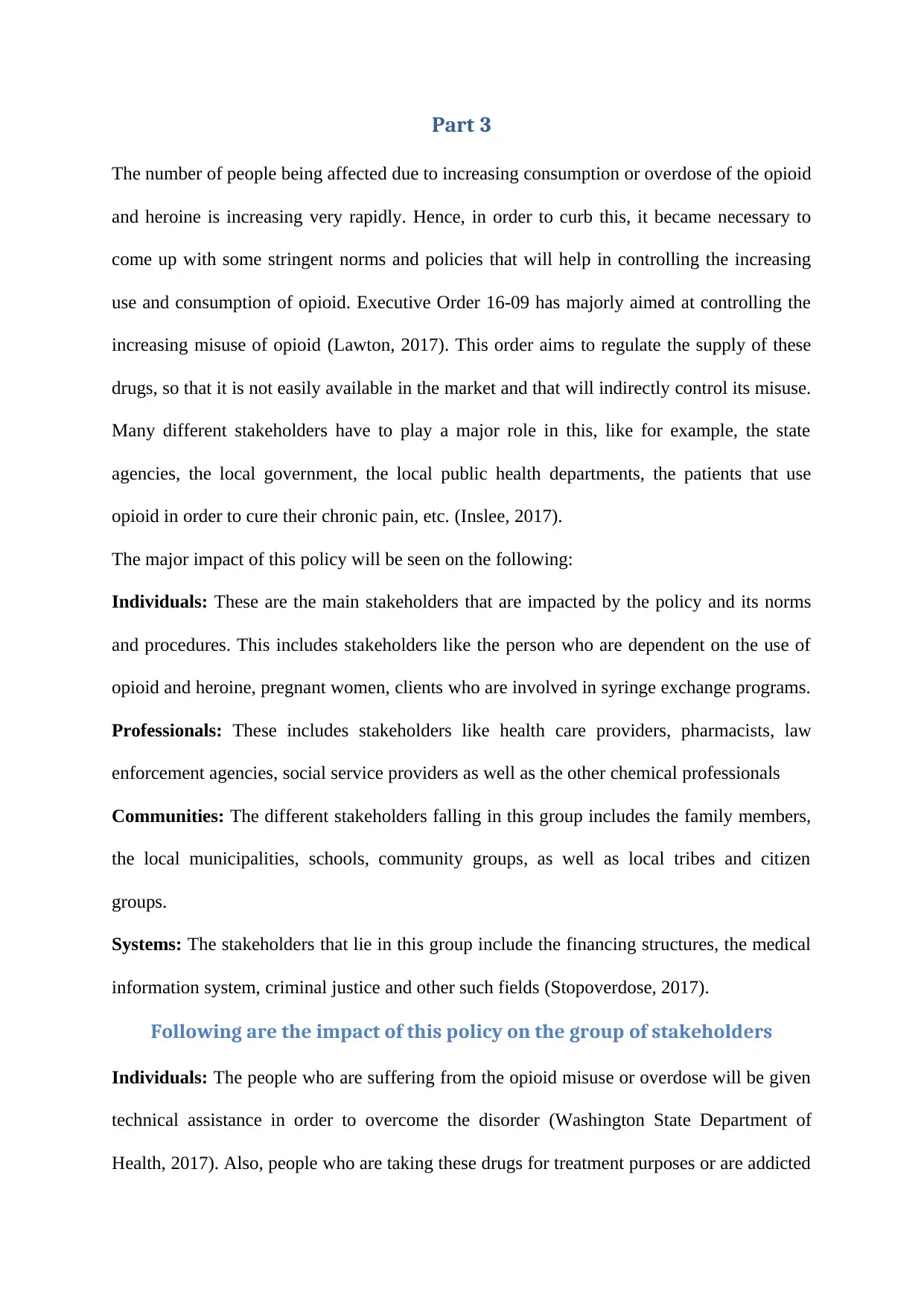
Part 3
The number of people being affected due to increasing consumption or overdose of the opioid
and heroine is increasing very rapidly. Hence, in order to curb this, it became necessary to
come up with some stringent norms and policies that will help in controlling the increasing
use and consumption of opioid. Executive Order 16-09 has majorly aimed at controlling the
increasing misuse of opioid (Lawton, 2017). This order aims to regulate the supply of these
drugs, so that it is not easily available in the market and that will indirectly control its misuse.
Many different stakeholders have to play a major role in this, like for example, the state
agencies, the local government, the local public health departments, the patients that use
opioid in order to cure their chronic pain, etc. (Inslee, 2017).
The major impact of this policy will be seen on the following:
Individuals: These are the main stakeholders that are impacted by the policy and its norms
and procedures. This includes stakeholders like the person who are dependent on the use of
opioid and heroine, pregnant women, clients who are involved in syringe exchange programs.
Professionals: These includes stakeholders like health care providers, pharmacists, law
enforcement agencies, social service providers as well as the other chemical professionals
Communities: The different stakeholders falling in this group includes the family members,
the local municipalities, schools, community groups, as well as local tribes and citizen
groups.
Systems: The stakeholders that lie in this group include the financing structures, the medical
information system, criminal justice and other such fields (Stopoverdose, 2017).
Following are the impact of this policy on the group of stakeholders
Individuals: The people who are suffering from the opioid misuse or overdose will be given
technical assistance in order to overcome the disorder (Washington State Department of
Health, 2017). Also, people who are taking these drugs for treatment purposes or are addicted
The number of people being affected due to increasing consumption or overdose of the opioid
and heroine is increasing very rapidly. Hence, in order to curb this, it became necessary to
come up with some stringent norms and policies that will help in controlling the increasing
use and consumption of opioid. Executive Order 16-09 has majorly aimed at controlling the
increasing misuse of opioid (Lawton, 2017). This order aims to regulate the supply of these
drugs, so that it is not easily available in the market and that will indirectly control its misuse.
Many different stakeholders have to play a major role in this, like for example, the state
agencies, the local government, the local public health departments, the patients that use
opioid in order to cure their chronic pain, etc. (Inslee, 2017).
The major impact of this policy will be seen on the following:
Individuals: These are the main stakeholders that are impacted by the policy and its norms
and procedures. This includes stakeholders like the person who are dependent on the use of
opioid and heroine, pregnant women, clients who are involved in syringe exchange programs.
Professionals: These includes stakeholders like health care providers, pharmacists, law
enforcement agencies, social service providers as well as the other chemical professionals
Communities: The different stakeholders falling in this group includes the family members,
the local municipalities, schools, community groups, as well as local tribes and citizen
groups.
Systems: The stakeholders that lie in this group include the financing structures, the medical
information system, criminal justice and other such fields (Stopoverdose, 2017).
Following are the impact of this policy on the group of stakeholders
Individuals: The people who are suffering from the opioid misuse or overdose will be given
technical assistance in order to overcome the disorder (Washington State Department of
Health, 2017). Also, people who are taking these drugs for treatment purposes or are addicted
Paraphrase This Document
Need a fresh take? Get an instant paraphrase of this document with our AI Paraphraser
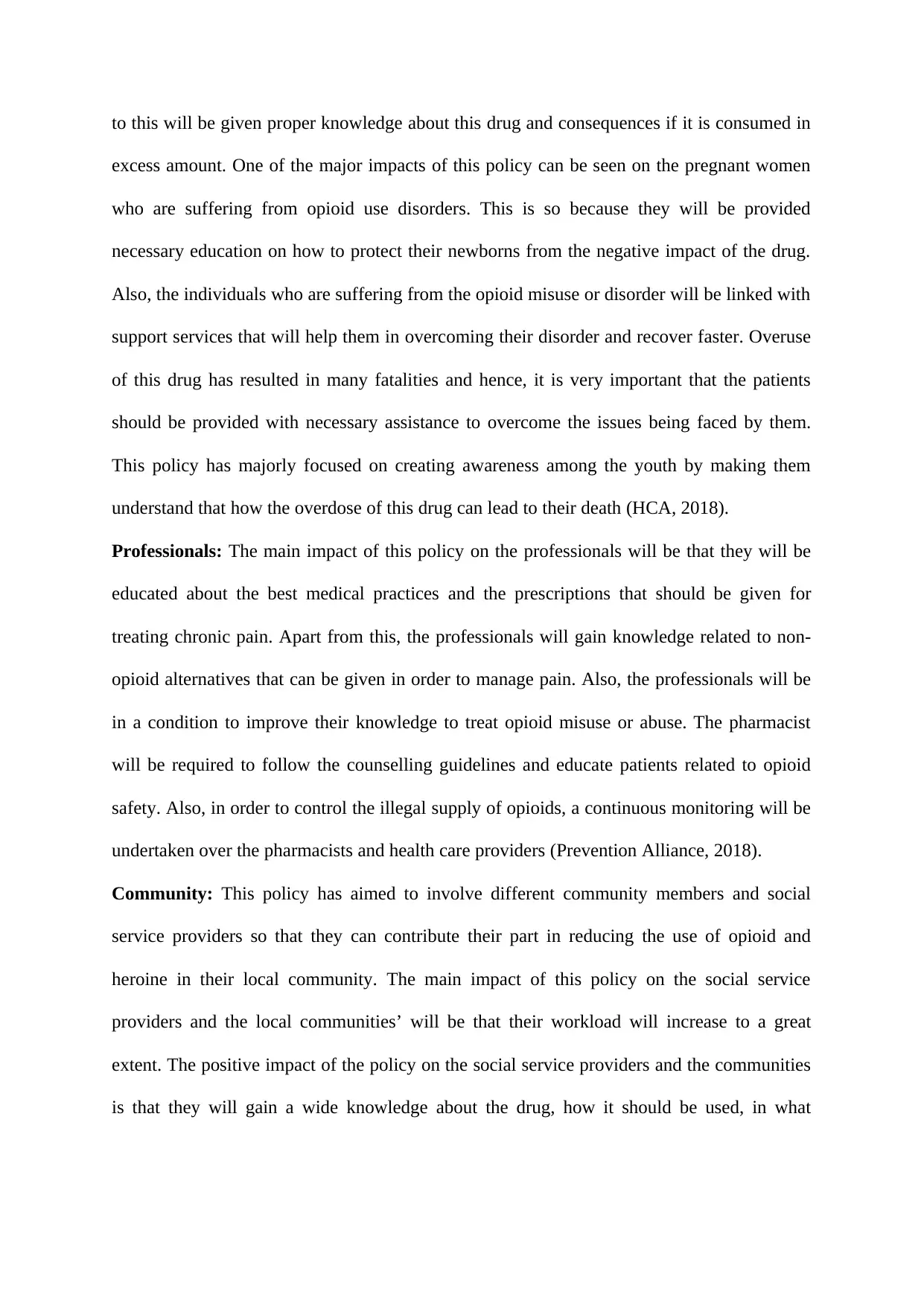
to this will be given proper knowledge about this drug and consequences if it is consumed in
excess amount. One of the major impacts of this policy can be seen on the pregnant women
who are suffering from opioid use disorders. This is so because they will be provided
necessary education on how to protect their newborns from the negative impact of the drug.
Also, the individuals who are suffering from the opioid misuse or disorder will be linked with
support services that will help them in overcoming their disorder and recover faster. Overuse
of this drug has resulted in many fatalities and hence, it is very important that the patients
should be provided with necessary assistance to overcome the issues being faced by them.
This policy has majorly focused on creating awareness among the youth by making them
understand that how the overdose of this drug can lead to their death (HCA, 2018).
Professionals: The main impact of this policy on the professionals will be that they will be
educated about the best medical practices and the prescriptions that should be given for
treating chronic pain. Apart from this, the professionals will gain knowledge related to non-
opioid alternatives that can be given in order to manage pain. Also, the professionals will be
in a condition to improve their knowledge to treat opioid misuse or abuse. The pharmacist
will be required to follow the counselling guidelines and educate patients related to opioid
safety. Also, in order to control the illegal supply of opioids, a continuous monitoring will be
undertaken over the pharmacists and health care providers (Prevention Alliance, 2018).
Community: This policy has aimed to involve different community members and social
service providers so that they can contribute their part in reducing the use of opioid and
heroine in their local community. The main impact of this policy on the social service
providers and the local communities’ will be that their workload will increase to a great
extent. The positive impact of the policy on the social service providers and the communities
is that they will gain a wide knowledge about the drug, how it should be used, in what
excess amount. One of the major impacts of this policy can be seen on the pregnant women
who are suffering from opioid use disorders. This is so because they will be provided
necessary education on how to protect their newborns from the negative impact of the drug.
Also, the individuals who are suffering from the opioid misuse or disorder will be linked with
support services that will help them in overcoming their disorder and recover faster. Overuse
of this drug has resulted in many fatalities and hence, it is very important that the patients
should be provided with necessary assistance to overcome the issues being faced by them.
This policy has majorly focused on creating awareness among the youth by making them
understand that how the overdose of this drug can lead to their death (HCA, 2018).
Professionals: The main impact of this policy on the professionals will be that they will be
educated about the best medical practices and the prescriptions that should be given for
treating chronic pain. Apart from this, the professionals will gain knowledge related to non-
opioid alternatives that can be given in order to manage pain. Also, the professionals will be
in a condition to improve their knowledge to treat opioid misuse or abuse. The pharmacist
will be required to follow the counselling guidelines and educate patients related to opioid
safety. Also, in order to control the illegal supply of opioids, a continuous monitoring will be
undertaken over the pharmacists and health care providers (Prevention Alliance, 2018).
Community: This policy has aimed to involve different community members and social
service providers so that they can contribute their part in reducing the use of opioid and
heroine in their local community. The main impact of this policy on the social service
providers and the local communities’ will be that their workload will increase to a great
extent. The positive impact of the policy on the social service providers and the communities
is that they will gain a wide knowledge about the drug, how it should be used, in what
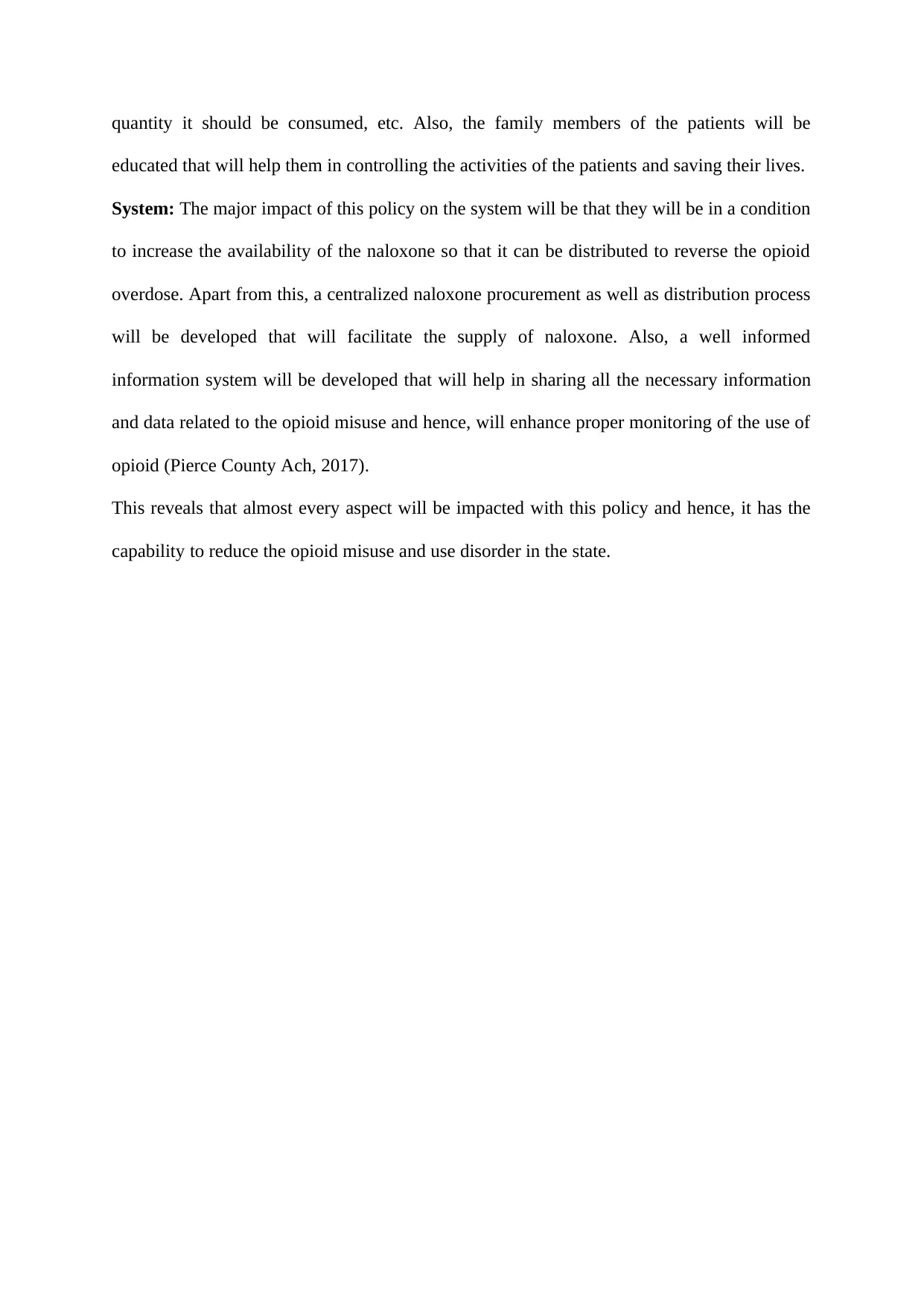
quantity it should be consumed, etc. Also, the family members of the patients will be
educated that will help them in controlling the activities of the patients and saving their lives.
System: The major impact of this policy on the system will be that they will be in a condition
to increase the availability of the naloxone so that it can be distributed to reverse the opioid
overdose. Apart from this, a centralized naloxone procurement as well as distribution process
will be developed that will facilitate the supply of naloxone. Also, a well informed
information system will be developed that will help in sharing all the necessary information
and data related to the opioid misuse and hence, will enhance proper monitoring of the use of
opioid (Pierce County Ach, 2017).
This reveals that almost every aspect will be impacted with this policy and hence, it has the
capability to reduce the opioid misuse and use disorder in the state.
educated that will help them in controlling the activities of the patients and saving their lives.
System: The major impact of this policy on the system will be that they will be in a condition
to increase the availability of the naloxone so that it can be distributed to reverse the opioid
overdose. Apart from this, a centralized naloxone procurement as well as distribution process
will be developed that will facilitate the supply of naloxone. Also, a well informed
information system will be developed that will help in sharing all the necessary information
and data related to the opioid misuse and hence, will enhance proper monitoring of the use of
opioid (Pierce County Ach, 2017).
This reveals that almost every aspect will be impacted with this policy and hence, it has the
capability to reduce the opioid misuse and use disorder in the state.
⊘ This is a preview!⊘
Do you want full access?
Subscribe today to unlock all pages.

Trusted by 1+ million students worldwide
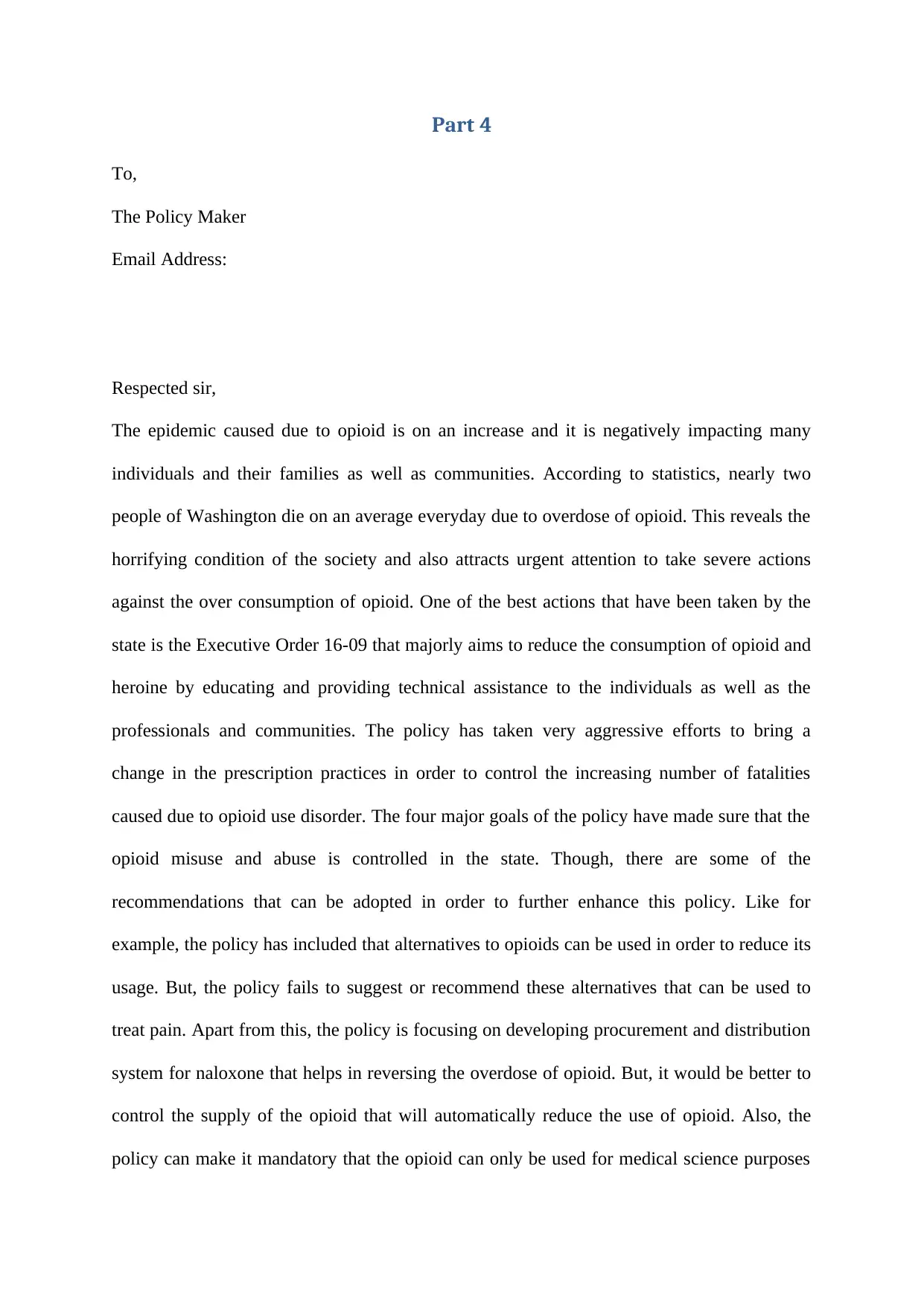
Part 4
To,
The Policy Maker
Email Address:
Respected sir,
The epidemic caused due to opioid is on an increase and it is negatively impacting many
individuals and their families as well as communities. According to statistics, nearly two
people of Washington die on an average everyday due to overdose of opioid. This reveals the
horrifying condition of the society and also attracts urgent attention to take severe actions
against the over consumption of opioid. One of the best actions that have been taken by the
state is the Executive Order 16-09 that majorly aims to reduce the consumption of opioid and
heroine by educating and providing technical assistance to the individuals as well as the
professionals and communities. The policy has taken very aggressive efforts to bring a
change in the prescription practices in order to control the increasing number of fatalities
caused due to opioid use disorder. The four major goals of the policy have made sure that the
opioid misuse and abuse is controlled in the state. Though, there are some of the
recommendations that can be adopted in order to further enhance this policy. Like for
example, the policy has included that alternatives to opioids can be used in order to reduce its
usage. But, the policy fails to suggest or recommend these alternatives that can be used to
treat pain. Apart from this, the policy is focusing on developing procurement and distribution
system for naloxone that helps in reversing the overdose of opioid. But, it would be better to
control the supply of the opioid that will automatically reduce the use of opioid. Also, the
policy can make it mandatory that the opioid can only be used for medical science purposes
To,
The Policy Maker
Email Address:
Respected sir,
The epidemic caused due to opioid is on an increase and it is negatively impacting many
individuals and their families as well as communities. According to statistics, nearly two
people of Washington die on an average everyday due to overdose of opioid. This reveals the
horrifying condition of the society and also attracts urgent attention to take severe actions
against the over consumption of opioid. One of the best actions that have been taken by the
state is the Executive Order 16-09 that majorly aims to reduce the consumption of opioid and
heroine by educating and providing technical assistance to the individuals as well as the
professionals and communities. The policy has taken very aggressive efforts to bring a
change in the prescription practices in order to control the increasing number of fatalities
caused due to opioid use disorder. The four major goals of the policy have made sure that the
opioid misuse and abuse is controlled in the state. Though, there are some of the
recommendations that can be adopted in order to further enhance this policy. Like for
example, the policy has included that alternatives to opioids can be used in order to reduce its
usage. But, the policy fails to suggest or recommend these alternatives that can be used to
treat pain. Apart from this, the policy is focusing on developing procurement and distribution
system for naloxone that helps in reversing the overdose of opioid. But, it would be better to
control the supply of the opioid that will automatically reduce the use of opioid. Also, the
policy can make it mandatory that the opioid can only be used for medical science purposes
Paraphrase This Document
Need a fresh take? Get an instant paraphrase of this document with our AI Paraphraser
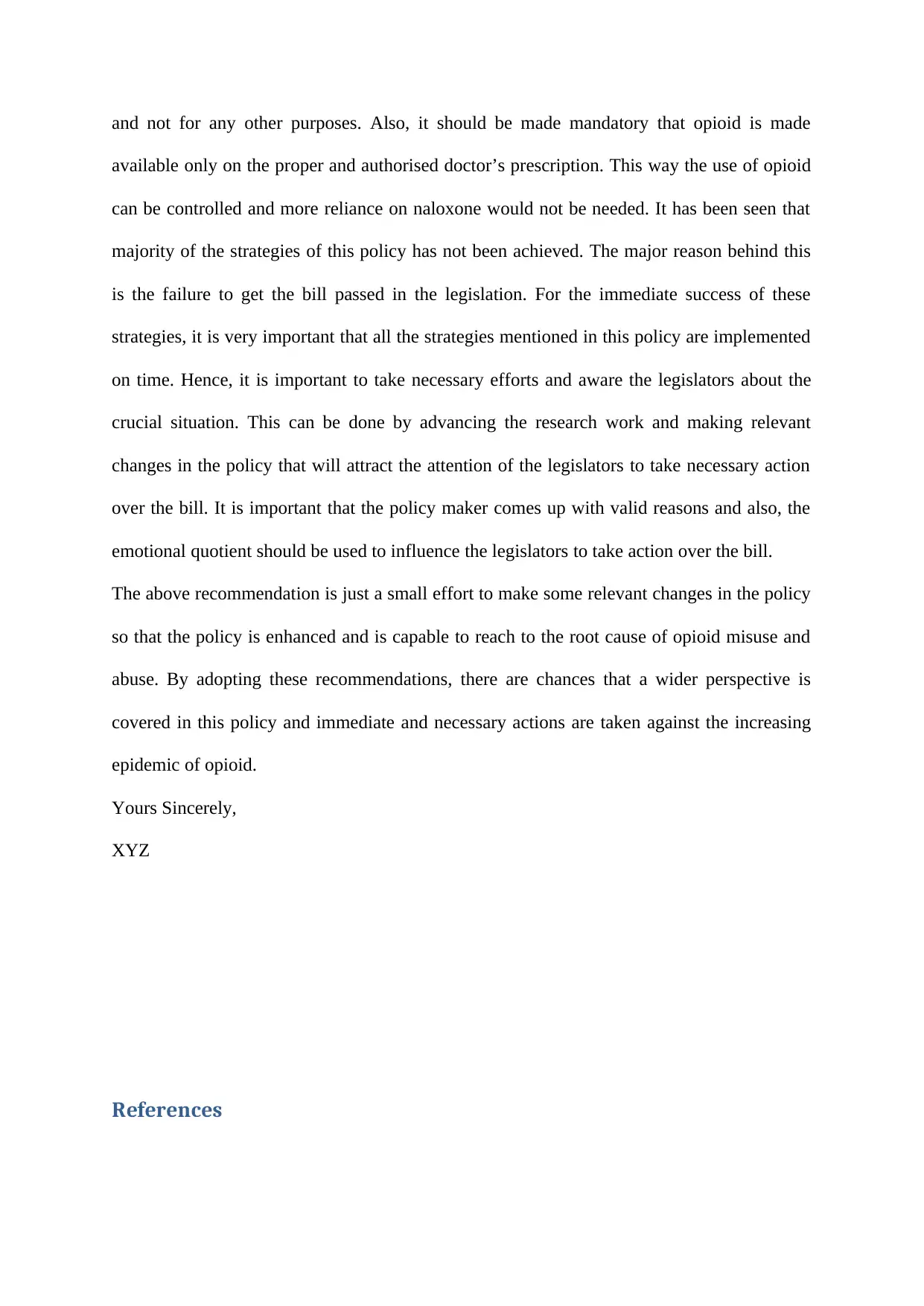
and not for any other purposes. Also, it should be made mandatory that opioid is made
available only on the proper and authorised doctor’s prescription. This way the use of opioid
can be controlled and more reliance on naloxone would not be needed. It has been seen that
majority of the strategies of this policy has not been achieved. The major reason behind this
is the failure to get the bill passed in the legislation. For the immediate success of these
strategies, it is very important that all the strategies mentioned in this policy are implemented
on time. Hence, it is important to take necessary efforts and aware the legislators about the
crucial situation. This can be done by advancing the research work and making relevant
changes in the policy that will attract the attention of the legislators to take necessary action
over the bill. It is important that the policy maker comes up with valid reasons and also, the
emotional quotient should be used to influence the legislators to take action over the bill.
The above recommendation is just a small effort to make some relevant changes in the policy
so that the policy is enhanced and is capable to reach to the root cause of opioid misuse and
abuse. By adopting these recommendations, there are chances that a wider perspective is
covered in this policy and immediate and necessary actions are taken against the increasing
epidemic of opioid.
Yours Sincerely,
XYZ
References
available only on the proper and authorised doctor’s prescription. This way the use of opioid
can be controlled and more reliance on naloxone would not be needed. It has been seen that
majority of the strategies of this policy has not been achieved. The major reason behind this
is the failure to get the bill passed in the legislation. For the immediate success of these
strategies, it is very important that all the strategies mentioned in this policy are implemented
on time. Hence, it is important to take necessary efforts and aware the legislators about the
crucial situation. This can be done by advancing the research work and making relevant
changes in the policy that will attract the attention of the legislators to take necessary action
over the bill. It is important that the policy maker comes up with valid reasons and also, the
emotional quotient should be used to influence the legislators to take action over the bill.
The above recommendation is just a small effort to make some relevant changes in the policy
so that the policy is enhanced and is capable to reach to the root cause of opioid misuse and
abuse. By adopting these recommendations, there are chances that a wider perspective is
covered in this policy and immediate and necessary actions are taken against the increasing
epidemic of opioid.
Yours Sincerely,
XYZ
References
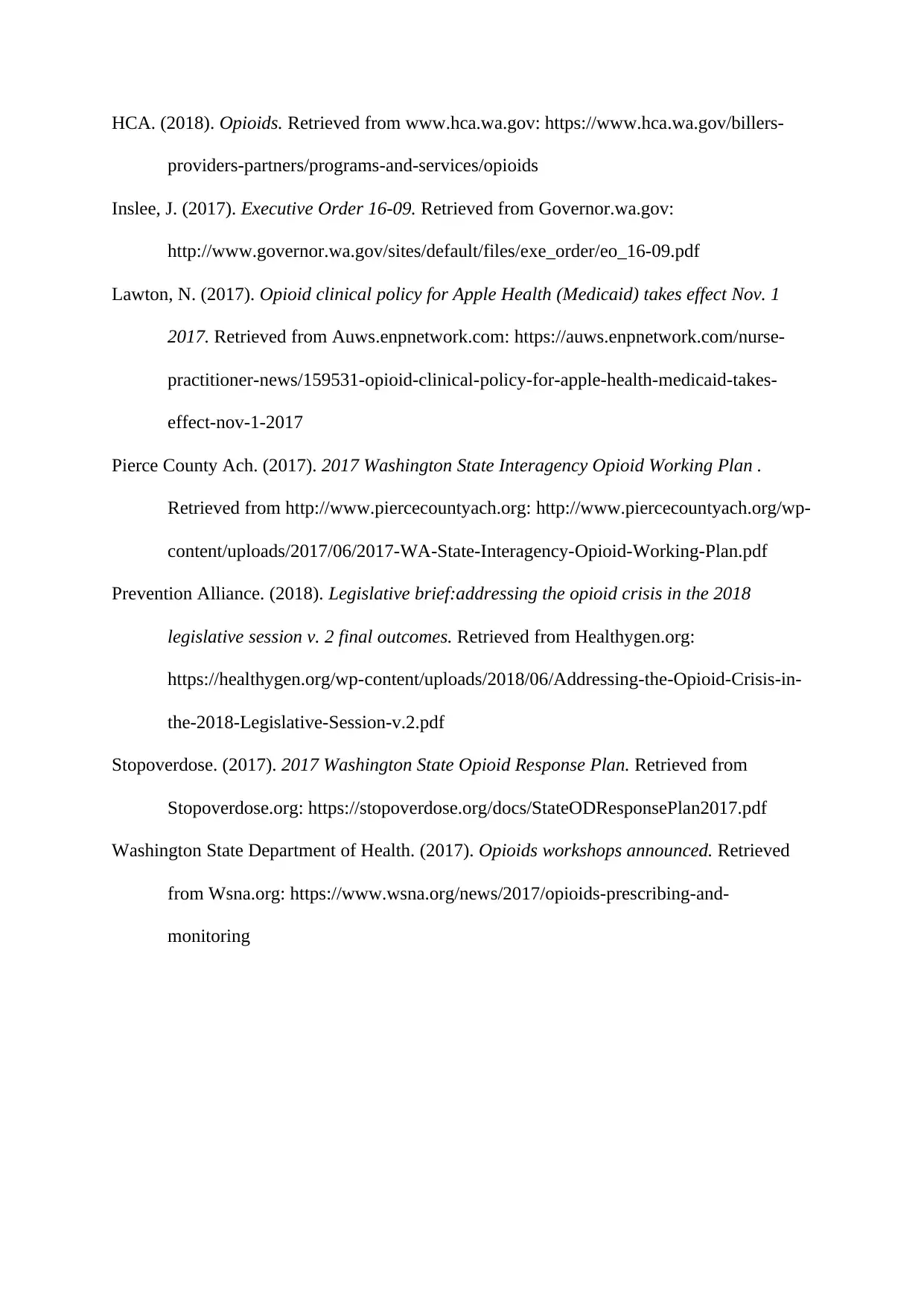
HCA. (2018). Opioids. Retrieved from www.hca.wa.gov: https://www.hca.wa.gov/billers-
providers-partners/programs-and-services/opioids
Inslee, J. (2017). Executive Order 16-09. Retrieved from Governor.wa.gov:
http://www.governor.wa.gov/sites/default/files/exe_order/eo_16-09.pdf
Lawton, N. (2017). Opioid clinical policy for Apple Health (Medicaid) takes effect Nov. 1
2017. Retrieved from Auws.enpnetwork.com: https://auws.enpnetwork.com/nurse-
practitioner-news/159531-opioid-clinical-policy-for-apple-health-medicaid-takes-
effect-nov-1-2017
Pierce County Ach. (2017). 2017 Washington State Interagency Opioid Working Plan .
Retrieved from http://www.piercecountyach.org: http://www.piercecountyach.org/wp-
content/uploads/2017/06/2017-WA-State-Interagency-Opioid-Working-Plan.pdf
Prevention Alliance. (2018). Legislative brief:addressing the opioid crisis in the 2018
legislative session v. 2 final outcomes. Retrieved from Healthygen.org:
https://healthygen.org/wp-content/uploads/2018/06/Addressing-the-Opioid-Crisis-in-
the-2018-Legislative-Session-v.2.pdf
Stopoverdose. (2017). 2017 Washington State Opioid Response Plan. Retrieved from
Stopoverdose.org: https://stopoverdose.org/docs/StateODResponsePlan2017.pdf
Washington State Department of Health. (2017). Opioids workshops announced. Retrieved
from Wsna.org: https://www.wsna.org/news/2017/opioids-prescribing-and-
monitoring
providers-partners/programs-and-services/opioids
Inslee, J. (2017). Executive Order 16-09. Retrieved from Governor.wa.gov:
http://www.governor.wa.gov/sites/default/files/exe_order/eo_16-09.pdf
Lawton, N. (2017). Opioid clinical policy for Apple Health (Medicaid) takes effect Nov. 1
2017. Retrieved from Auws.enpnetwork.com: https://auws.enpnetwork.com/nurse-
practitioner-news/159531-opioid-clinical-policy-for-apple-health-medicaid-takes-
effect-nov-1-2017
Pierce County Ach. (2017). 2017 Washington State Interagency Opioid Working Plan .
Retrieved from http://www.piercecountyach.org: http://www.piercecountyach.org/wp-
content/uploads/2017/06/2017-WA-State-Interagency-Opioid-Working-Plan.pdf
Prevention Alliance. (2018). Legislative brief:addressing the opioid crisis in the 2018
legislative session v. 2 final outcomes. Retrieved from Healthygen.org:
https://healthygen.org/wp-content/uploads/2018/06/Addressing-the-Opioid-Crisis-in-
the-2018-Legislative-Session-v.2.pdf
Stopoverdose. (2017). 2017 Washington State Opioid Response Plan. Retrieved from
Stopoverdose.org: https://stopoverdose.org/docs/StateODResponsePlan2017.pdf
Washington State Department of Health. (2017). Opioids workshops announced. Retrieved
from Wsna.org: https://www.wsna.org/news/2017/opioids-prescribing-and-
monitoring
⊘ This is a preview!⊘
Do you want full access?
Subscribe today to unlock all pages.

Trusted by 1+ million students worldwide
1 out of 6
Related Documents
Your All-in-One AI-Powered Toolkit for Academic Success.
+13062052269
info@desklib.com
Available 24*7 on WhatsApp / Email
![[object Object]](/_next/static/media/star-bottom.7253800d.svg)
Unlock your academic potential
Copyright © 2020–2025 A2Z Services. All Rights Reserved. Developed and managed by ZUCOL.





